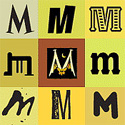 Historians tell us that our current M started out as the Egyptian hieroglyph for “Owl.” Over thousands of years, this simple line drawing was further distilled into the hieratic symbol for the ’em’ sound. Eventually, the great-grandparent of our M looked a bit like a handwritten ‘m’m balance on one tip of the stroke.
Historians tell us that our current M started out as the Egyptian hieroglyph for “Owl.” Over thousands of years, this simple line drawing was further distilled into the hieratic symbol for the ’em’ sound. Eventually, the great-grandparent of our M looked a bit like a handwritten ‘m’m balance on one tip of the stroke.
THE PHOENICIANS CALLED THE LETTER MEM. It is easy to see that the Phoenician mem is based on the Egyptian hieratic symbol, and that it is the forerunner of the thirteenth letter of our alphabet. The mem looked much like our two-bumped, lowercase ‘m’ with an added tail at the end.
 The Greek mu evolved from the Phoenician mem. The Greeks further simplified the letter and, in the process, converted the soft, round shapes into angular strokes.
The Greek mu evolved from the Phoenician mem. The Greeks further simplified the letter and, in the process, converted the soft, round shapes into angular strokes.
The Etruscans and the Romans adopted the Greek form, but neither made substantial changes to the shape or the proportions of the character. Sometime in the third or fourth century A.D. the rounded lowercase ‘m’ began to appear, but it was almost lost in the later centuries. In medieval writing, it became common practice to place a stroke over the preceding letter instead of writing the ‘m’ (probably because ‘m’ is one of the more time consuming letters to write).
The Romans also pressed the M and six other letters — I, X, V, L, C, and D — into double duty as their numerals, and gave the M the honor of standing in for the highest value, 1,000!
That’s the Letter ‘M’ for March and May!
Enjoy, and thank you Allan Haley for this historic minute.
Allan Haley is a long time hero of the Design Center, and his expertise in typography and typographic design is second to none. His clients include Apple, Adobe, Linotype, Xerox, IBM, and Agfa Monotype among others. He is also currently the Chairman of the Advisory Board of the Goudy International Center at RIT. Allan was executive vice president of ITC, And before that was in charge of typographic development at Compugraphic Corp. (now Agfa Monotype). He writes for publications such as U&lc, How, Dynamic Graphics, and Step-by-Step Graphics. He is highly regarded as an educator, and he is a frequently requested speaker. He has written five books on type and graphic communication.
See all my pins . . . the years of the typography blog . . .
Enjoy our May poster . . .
